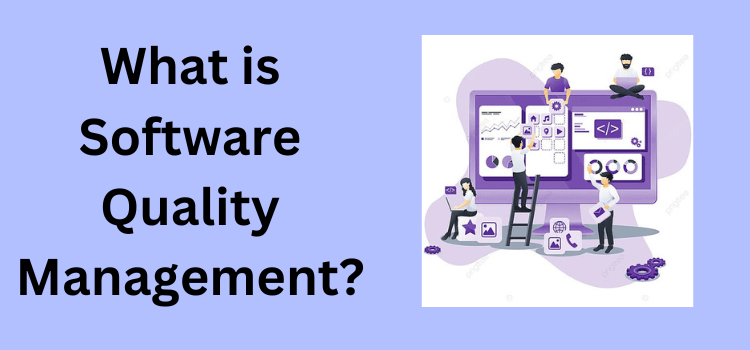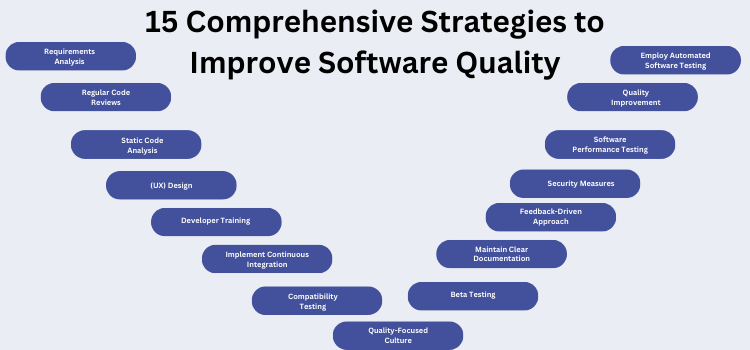In the dynamic landscape of software development, the pursuit of optimal quality remains a paramount concern. How to improve software quality is a question that resonates deeply with developers, businesses, and users alike.
Enhancing software quality goes beyond mere bug-fixing; it encompasses a holistic approach that ensures robustness, reliability, and user satisfaction.
This introduction delves into key strategies that empower developers to raise the bar on software quality, from rigorous testing and streamlined development processes to user-centric design and continuous refinement.
Whether refining existing projects or embarking on new ones, embracing these methodologies is essential for delivering software that stands the test of time.
What is Software Quality?
Imagine you’re picking out a car. It’s not just about the color or style, but how it performs – the efficiency, safety features, and the feel when you’re driving. Software quality is similar.
It isn’t merely about how the software looks, but how it functions, its performance, reliability, and the overall experience for the user.
Software quality is a comprehensive measure that determines how effective, efficient, and user-friendly a software product is. High-quality software not only meets its intended purpose without significant issues but also provides a positive experience for its users.
Software quality is just as important as choosing a car with excellent mileage, reliable safety features, and smooth handling. Nobody wants software that constantly crashes or is difficult to use, just as no one would choose a car that frequently breaks down or is uncomfortable to drive.

What is Software Quality Management?
Let’s return to our car analogy. Now, consider the meticulous process and oversight involved in ensuring that every part of the car is perfect – from engine functionality to the paint job.
Software Quality Management (SQM) is the equivalent in the digital realm.
SQM refers to the strategies, methodologies, and processes used to ensure that a software product meets and exceeds the standards of quality. It involves a thorough process that starts from understanding requirements to testing the software for defects.
In a manufacturing facility, SQM is the quality assurance team continuously checking, rechecking, and refining the process.
In essence, Software Quality Management is a proactive approach to guaranteeing that a software product is of top-tier quality. This not only means bug-free code but also user-centric design, optimum performance, and robust security measures.
In the long run, businesses can ensure their software not only meets but exceeds user expectations through an effective SQM.

Exploring the Triple C’s of Stellar Software Quality
Unraveling the complexities of software quality boils down to three pivotal pillars. Let’s dive into these guiding principles —
Clarity in Function
Software should do exactly what it’s supposed to. Any glitch, bug, or unexpected behavior deviates from its main objective. Ensuring your software operates flawlessly and aligns with the user’s expectations is essential.
Comprehensive Design
Your software should tick all boxes of its set requirements. If it claims to offer ten features, each of those ten should work seamlessly. Delivering on promises and ensuring all functionalities are present is key to satisfying users.
Uniformity Across Boards
Whether a user accesses your software on a vintage Windows XP or the latest Mac, its behavior should remain constant. Offering a predictable experience across various environments amplifies the software’s reliability and widens its user base.

15 Comprehensive Strategies to Improve Software Quality
Below are the strategies that you can apply to upscale quality of your software.
Incorporate Requirements Analysis
The foundation of any successful software project lies in its requirements. Proper requirements analysis involves a deep dive into what the stakeholders expect from the software and translating these expectations into actionable specifications.
When developers engage stakeholders and clarify every detail, they can avoid ambiguities and misunderstandings that can lead to costly corrections in the future. Moreover, this proactive approach ensures the team is aligned from the onset, and resources are allocated efficiently.
Ultimately, a comprehensive requirements analysis ensures that the final product resonates with its target audience, meeting both functional and non-functional needs.
Employ Automated Software Testing
In the modern software development lifecycle, speed is of the essence. However, speed shouldn’t compromise quality. This is where automated testing comes in. Automated tests are scripts that automatically execute predefined actions and then compare the actual outcome with the expected result.
They save countless hours by quickly identifying regressions and defects in the codebase. Beyond efficiency, they offer consistency, as they test functionalities the exact same way every time.
This repeatability ensures that even as code changes, the software’s integrity remains intact. In essence, automated testing is a powerful tool to maintain and elevate software quality in agile environments.
Facilitate Regular Code Reviews
Peer code reviews are a collaborative practice where developers evaluate each other’s code before it’s merged into the mainline. This process serves multiple purposes —
- it checks for coding errors
- ensures alignment with best practices
- promotes knowledge sharing among the team
Regular code reviews not only help in catching potential bugs early but also foster a culture of collective responsibility and continuous learning. Through code reviews, unchecked codebases accumulate technical debt and become cleaner, more efficient, and safer.
Quality Improvement through Version Control
Version control systems, like Git or Mercurial, are indispensable tools in the software development world. They track and manage codebase changes, allowing multiple developers to work on the same project simultaneously without interfering.
With a version control system, teams can revert to previous states, compare changes, and resolve conflicts with ease. By maintaining a historical record of the entire project, it provides a safety net against unforeseen errors and promotes collaborative work.
As a result, a version control system ensures code quality remains high even during constant updates.
Introduce Static Code Analysis
Static code analysis involves inspecting code without executing it. This process uses specialized tools to sift through code lines and identify potential vulnerabilities, errors, or deviations from coding standards.
It’s like having an automated proofreader for your code. Static code analysis helps developers spot problems early by identifying memory leaks, potential buffer overflows, and redundant code.
Moreover, it reinforces best coding practices, ensuring the codebase remains clean and maintainable. Integrating static code analysis into the development pipeline significantly elevates the reliability and security of the software.
Leverage Software Performance Testing
It’s about ensuring your software not only works but works efficiently under the intended load. It assesses how the system behaves under pressure, be it from a surge in user traffic, data processing, or intense computational tasks.
Testers identify bottlenecks, slow response times, and potential crashes by simulating different environments and scenarios. When the software is in the hands of users, this proactive approach ensures it remains responsive, reliable, and robust during peak times.
In a world where users expect instantaneous feedback, leveraging performance testing is crucial to deliver a seamless user experience.
Enhance User Experience (UX) Design
At the heart of software quality lies a paramount principle: the user’s experience. Enhancing UX design goes beyond aesthetics; it’s about intuitiveness, accessibility, and responsiveness.
A software can have impeccable code, but if users find it cumbersome or confusing, its value diminishes. Recognizing the importance of software quality, many companies are now investing more in UX to ensure their applications are user-centric.
Refining UX design is part of software quality management, ensuring that the software works and thrills users.
Prioritize Security Measures
In today’s digital era, the significance of security can’t be overstated. With rising cyber threats, ensuring the safety of user data and system integrity is paramount for maintaining software quality.
It’s not just about building defenses against external threats but also about safeguarding from internal vulnerabilities that might be exploited. Software quality management places a strong emphasis on robust security protocols.
Prioritizing security measures acts as a testament to a company’s commitment to the safety and quality of its software.
Support Developer Training to Testing Team
There are always new technologies, methodologies, and best practices emerging in software development. To ensure software quality remains at the forefront, continuous developer training is essential.
It improves code quality and reinforces the importance of software quality within the team by upskilling developers. Software quality management pillars are upheld when teams maintain their skills through workshops, courses, and certifications.
Cultivate a Feedback-Driven Approach
In the realm of software development, understanding the value of quality software often hinges on listening to the end-users. A feedback-driven approach offers invaluable insights into how software performs in real-world scenarios, revealing areas of improvement.
Shared user experiences, whether they’re positive or not, strengthen software quality management. By analyzing feedback, developers can refine software functionalities, making them more aligned with user needs and expectations.
In addition to enhancing software quality, this approach fosters trust and transparency between developers and users.
Implement Continuous Integration
The dynamism of software development necessitates mechanisms that ensure code modifications don’t introduce new errors. CI (Continuous Integration) refers to the practice of continuously merging software changes into a central repository, then running automated tests.
CI emphasizes the importance of software quality by ensuring that bugs or inconsistencies are detected and addressed promptly. It promotes a more cohesive, error-free codebase by providing developers with real-time feedback.
Through CI, teams can maintain the highest standards of software quality, even in fast-paced development environments.
Maintain Clear Documentation
One of the pillars that uphold software quality is comprehensive and clear documentation. Beyond its utility for developers, well-maintained documentation serves as a testament to the quality of software.
It offers a roadmap, detailing how software components interact, the logic behind certain functionalities, and guidelines for future modifications. Software quality management requires clear documentation to ensure that software integrity remains intact as teams evolve or change.
Additionally, thorough documentation facilitates onboarding for new team members and minimizes misinterpretation errors.
Factor in Compatibility Testing
Compatibility testing underscores the need for quality software across devices, operating systems, and browsers. This testing ensures software performs consistently across various environments.
It’s a critical aspect of software quality management, given the plethora of configurations users might employ. Assuring Software compatibility enhances user experience and affirms developers’ commitment to comprehensive software quality.
A seamless performance across different platforms and devices accentuates the software’s adaptability and robustness in diverse scenarios.
Engage in Beta Testing
Beta testing is a strategic step in the software quality management process. It involves releasing the software to a select group of users before the official launch.
Their real-world interaction uncovers potential bugs, usability issues, and areas for improvement. With beta testing, developers get valuable feedback not available in controlled testing environments, which may lead to poor software quality.
This iterative process ensures that the software meets user expectations, reducing post-launch issues and enhancing the overall software quality.
Promote a Quality-Focused Culture
Software quality isn’t just about bug-free code or optimal performance; it’s also about fostering a culture that prioritizes excellence. From conception to deployment, promoting a quality-focused culture emphasizes software quality.
It results in fewer errors, better user experiences, and increased customer satisfaction when every team member values software quality. In such a culture, software quality management becomes more holistic, ensuring that the end product is not just functional but exceptional.
Wrapping Up
The journey to enhance software quality is continuous and ever-evolving. In our rapidly progressing technological world, the role of software quality and its management can’t be overstated.
Adopting the right strategies, tools, and practices is crucial. Remember, it’s not just about creating software; it’s about crafting an impeccable experience for the end user.
So, as we reflect on the question, “How to improve software quality?”, we must commit to a holistic approach that values user feedback, employs rigorous testing, and keeps pace with technological advancements.
Frequently Asked Questions
Why is software quality essential?
Software quality directly impacts user experience, determines software longevity, and affects a company’s reputation.
What are the key components of software quality?
They include —
- functionality
- reliability
- usability
- efficiency
- maintainability
- portability
How does software quality management benefit developers?
It provides a structured approach to improving product quality, offers guidelines for best practices, and encourages a culture of continuous improvement.
- Web Application Testing Tools: An In-Depth Comparison And Review - December 31, 2023
- We Tried 7 Best Puppeteer Alternatives [in-Depth Comparison 2024] - December 31, 2023
- Top 10 Cloud Testing Tools For Cloud-Based Apps 2024 - December 31, 2023